https://en.wikipedia.org/wiki/Latin_hip_hop
https://en.wikipedia.org/wiki/Latin_trap
In 2015, a new movement of trap music referred to as "Latin trap" began to emerge.[19] Also known as Spanish-language trap, Latin trap similar to mainstream trap which details "'la calle,' or the streets — hustling, sex, and drugs".[20] Prominent artists of Latin trap include Messiah, Fuego, Anuel AA and Bad Bunny.[21] In July 2017, The Fader wrote "Rappers and reggaetoneros from Puerto Rico to Colombia have taken elements of trap — the lurching bass lines, jittering 808s and the eyes-half-closed vibe — and infused them into banger after banger."[21] In an August 2017 article for Billboard's series, "A Brief History Of," they enlisted some of the key artists of Latin trap—including Ozuna, De La Ghetto, Bad Bunny, Farruko and Messiah—to narrate a brief history on the genre.[19][22] Elias Leight of Rolling Stone noted "[Jorge] Fonseca featured Puerto Rican artists like Anuel AA, Bryant Myers and Noriel on the compilation Trap Capos: Season 1, which became the first "Latin trap" LP to reach Number One on Billboard's Latin Rhythm Albums chart."[23] A remixed version of Cardi B's hit single "Bodak Yellow" (which reached number one on the US Billboard Hot 100 chart), dubbed the "Latin Trap Remix", was officially released on August 18, 2017 and features Cardi B rapping in the Spanish language with Dominican hip hop recording artist Messiah contributing a guest verse.[24][25][26] In November 2017, Rolling Stone wrote that "a surging Latin trap sound is responding to more recent developments in American rap, embracing the slow-rolling rhythms and gooey vocal delivery popularized by Southern hip-hop."[23]
2015年、「ラテン・トラップ」と呼ばれるトラップ・ミュージックの新たなムーブメントが出現し始めた[19]。スペイン語トラップとしても知られるラ テン・トラップは、「"la calle(ラ・カレ)"、つまりストリート(ハッスル、セックス、ドラッグ)」を詳述するメインストリーム・トラップに似ている[20]。ラテン・ト ラップの著名なアーティストには、Messiah、Fuego、Anuel AA、Bad Bunnyがいる。 [21]2017年7月、The Faderは「プエルトリコからコロンビアまでのラッパーとレゲトネーロは、トラップの要素-揺れるベースライン、ジタバタする808s、目を半分閉じた ヴァイブ-を取り入れ、バンガーに次ぐバンガーに吹き込んだ。 21] Billboardの2017年8月の記事 "A Brief History Of "では、Ozuna、De La Ghetto、Bad Bunny、Farruko、Messiahなど、ラテン・トラップの主要アーティストを起用し、このジャンルの簡単な歴史を語っている[19] [22]。 Rolling StoneのElias Leightは、「[Jorge] Fonsecaは、コンピレーション『Trap Capos』でAnuel AA、Bryant Myers、Norielといったプエルトリコのアーティストをフィーチャーした: シーズン1は、ビルボードのラテンリズムアルバムチャートで1位を獲得した初の "ラテントラップ "LPとなった」[23] カーディ・Bのヒットシングル "Bodak Yellow"(USビルボードホット100チャートで1位を獲得)のリミックスバージョンは、"Latin Trap Remix "と名付けられ、2017年8月18日に正式にリリースされ、ドミニカのヒップホップレコーディングアーティストMessiahがゲストヴァースを提供 し、カーディ・Bがスペイン語でラップしている。 [24][25][26]2017年11月、ローリング・ストーン誌は「急成長するラテン・トラップ・サウンドは、アメリカン・ラップのより最近の展開に 呼応しており、南部のヒップホップによって普及した、ゆったりとしたリズムとねっとりとしたヴォーカルを受け入れている」と書いている[23]。
Latin rap
In the late 1980s and early 1990s, most Latin rap came from New York and the West Coast of the United States. Due to the heaviest Puerto Rican migration to New York City in the '50s, during the 70s, the birth of hip hop involved Latinos from the Caribbean islands. DJ Kool Herc was from Jamaica. Puerto Rico loved Hip Hop from America. Among the first rappers from the island were Ruben DJ, Vico-C, TNT, Brewley MC. Later generations saw talented MCs, DJs and groups emerge all over the island. And artists from this period include Daddy Yankee, Anuel AA,[1] Big Boy, MC Ceja, Ivy Queen, Mexicano, Chezina, Lito y Polaco, and Kool Bob Love.[2]
Mellow Man Ace was the first Latino artist to have a major bilingual single, the 1989 track "Mentirosa". This song went platinum, leading Mellow Man Ace to be described as the "Godfather of Latin rap" and inducted into the Hip Hop Hall of Fame inductee. In 1990, fellow West Coast artist Kid Frost further brought Latinos to the rap forefront with his hit song "La Raza (song)." In 1991, Kid Frost, Mellow Man, A.L.T. and several other Latin rappers formed the rap super group Latin Alliance and released a self-titled album which featured the hit "Lowrider (On the Boulevard)". A.L.T. also scored a hit later that year with his remake of the song Tequila. Cypress Hill, of which Mellow Man Ace was a member before going solo, would become the first Latino rap group to reach platinum status in 1991. The group has since continued to release other Gold and Platinum albums. Ecuadorian born rapper Gerardo received heavy rotation on video and radio for his single "Rico, Suave". While commercially watered-down, his album enjoyed a status of being one of the first mainstream Spanglish CDs on the market. Johnny J was a multi-platinum songwriter, music producer, and rapper who was perhaps best known for his production on Tupac Shakur's albums All Eyez on Me and Me Against the World.[3] He also produced the 1990 single Knockin' Boots for his classmate Candyman's album Ain't No Shame in My Game, which eventually went platinum thanks to the single.[4]
In the mid-1990s, the success of LA's Cypress Hill led to additional Latin hip-hop artists finding label support. Delinquent Habits were a horn-sampling trio that found MTV support for their breakout bilingual single "Tres Delinquentes" in 1996. By the early 2000's, two Mexico-born, United States-raised Latin hip hop acts found success on major labels. LA's Akwid fused banda with hip-hop on hits like "No Hay Manera" while Milwaukee's Kinto Sol told tales of Mexican immigrant life over more minimalist beats. The genre even spawned a bicultural novelty, the Brooklyn-based crew Hip Hop Hoodíos, who fused their dual Jewish and Latino cultures on songs like "Havana Nagila" and "Raza Hoodía."
Latin rap in the East Coast and Miami
DJ Charlie Chase fused hip-hop with salsa and other music genres. Chase was the DJ for the New York hip-hop group the Cold Crush Brothers, from 1978 and through the '80s. East Coast Latin artists such as the Beatnuts emerged in the early 1990s, with New Jersey native Chino XL earning recognition for his lyricism and equal controversy for his subject matter. In 1992, Mesanjarz of Funk, led by the Spanish/English flow of Mr. Pearl, became the first Spanish rap group signed to a major label (Atlantic Records). In 1994, Platinum Producer and DJ Frankie Cutlass used his own label, Hoody Records, to produce his single “Puerto Rico” which became a classic. In the late 1990s, Puerto Rican rapper Big Punisher became the first Latino solo artist to reach platinum sales for an LP with his debut album Capital Punishment, which included hit song "Still Not a Player".
Southwest and Chicano rap
Latin rap (as well as its subgenre of Chicano rap) has thrived along the West Coast, Southwest and Midwestern states with little promotion due to the large Latino populations of those regions. Jonny Z is considered to be a pioneer of Latin hip-hop, due to him being one of the first Latinos combining Spanglish lyrics with freestyle, salsa, mambo, and regional Mexican banda. He scored four Billboard Hot Dance singles between 1993 and 1997, including one of the greatest Miami bass songs of all time, "Shake Shake (Shake That Culo)". Besides bass music, he also recorded the Chicano anthem "Orale". The Oxford Encyclopedia of Latinos and Latinas in the United States Volume 2, Page 301 states: "A new style of Latina and Latino hip-hop was created in Miami and Texas by the bass rappers DJ Laz and Jonny Z, who mixed Latin styles with bass music".[5]
ラテンラップ
1980年代後半から1990年代前半にかけて、ラテン・ラップのほとんどはニューヨークとアメリカ西海岸から生まれた。50年代にプエルトリコから ニューヨークへの移民が最も多かったため、70年代にはカリブ海諸島出身のラテン系がヒップホップの誕生に関わった。DJクール・ハークはジャマイカ出身 だった。プエルトリコはアメリカ発のヒップホップが大好きだった。同島出身の最初のラッパーには、ルーベンDJ、ヴィコ-C、TNT、ブリューリーMCら がいる。その後の世代では、才能あるMC、DJ、グループが島中に出現した。そしてこの時期のアーティストには、ダディ・ヤンキー、アヌエルAA、[1] ビッグ・ボーイ、MCセハ、アイビー・クイーン、メヒカーノ、チェジーナ、リト・イ・ポラコ、クール・ボブ・ラブなどがいる[2]。
メロウ・マン・エースは、1989年の「Mentirosa」という曲で、メジャーなバイリンガル・シングルを出した最初のラテン系アーティストである。 この曲はプラチナ・ディスクを獲得し、メロウ・マン・エースは「ラテン・ラップのゴッドファーザー」と評され、ヒップホップの殿堂入りを果たした。 1990年、同じ西海岸出身のアーティスト、キッド・フロストは、ヒット曲 "La Raza(歌)"でラテン系をラップの最前線に押し上げた。1991年、キッド・フロスト、メロウ・マン、A.L.T.ら数人のラテン系ラッパーがラッ プ・スーパーグループ、ラテン・アライアンスを結成し、ヒット曲 "Lowrider (On the Boulevard) "を収録したセルフタイトルのアルバムをリリース。A.L.T.は同年末、テキーラのリメイクもヒットさせた。メロウ・マン・エースがソロになる前にメン バーだったサイプレス・ヒルは、1991年にラテン系ラップ・グループとして初めてプラチナ・ディスクを獲得した。同グループはその後もゴールド・アルバ ムやプラチナ・アルバムをリリースし続けている。エクアドル生まれのラッパー、ジェラルドはシングル「Rico, Suave」でビデオやラジオでヘビーローテーションされた。商業的には水増しされたものの、彼のアルバムは、市場で最初に主流となったスパングリッシュ CDのひとつという地位を得た。ジョニーJは、おそらくトゥパック・シャカーのアルバム『オール・アイズ・オン・ミー』と『ミー・アゲインスト・ザ・ワー ルド』のプロデュースで最もよく知られたマルチ・プラチナム・ソングライター、音楽プロデューサー、ラッパーである[3]。彼はまた、同級生キャンディマ ンのアルバム『エイント・ノー・シェイム・イン・マイ・ゲーム』のために1990年のシングル『ノッキン・ブーツ』をプロデュースし、このシングルのおか げで最終的にプラチナ・ディスクを獲得した[4]。
1990年代半ば、LAのサイプレス・ヒルの成功により、ラテン系ヒップホップ・アーティストがレーベルのサポートを得るようになった。デリンケント・ハ ビッツはホーン・サンプリングのトリオで、1996年にブレイクしたバイリンガルシングル「Tres Delinquentes」でMTVのサポートを得た。2000年代初頭には、メキシコ生まれでアメリカ育ちのラテン・ヒップホップ・アーティスト2組が メジャー・レーベルで成功を収めた。ロサンゼルスのアクウィッドは「No Hay Manera」などのヒット曲でバンダとヒップホップを融合させ、ミルウォーキーのキント・ソルはよりミニマルなビートに乗せてメキシコ移民の生活を語っ ていた。このジャンルは、"Havana Nagila "や "Raza Hoodía "といった曲で、ユダヤ系とラテン系の2つの文化を融合させた、ブルックリンを拠点とするクルー、ヒップホップ・フーディオスというバイカルチュラルな新 人をも生み出した。
東海岸とマイアミのラテン・ラップ
DJのチャーリー・チェイスは、ヒップホップとサルサやその他の音楽ジャンルを融合させた。チェイスは1978年から80年代まで、ニューヨークのヒップ ホップ・グループ、コールド・クラッシュ・ブラザーズのDJを務めた。1990年代初頭には、ビートナッツのような東海岸のラテン系アーティストが登場 し、ニュージャージー出身のチノXLは、そのリリシズムが評価される一方で、その題材が物議を醸した。1992年、スペイン語と英語を操るミスター・パー ル率いるメサンジャールズ・オブ・ファンクは、メジャー・レーベル(アトランティック・レコード)と契約した初のスパニッシュ・ラップ・グループとなっ た。1994年、プラチナ・プロデューサー兼DJのフランキー・カトラスは、自身のレーベル、フーディー・レコードを使ってシングル「Puerto Rico」をプロデュースし、この曲はクラシックとなった。1990年代後半、プエルトリコ出身のラッパー、ビッグ・パニッシャーは、ヒット曲 「Still Not a Player」を含むデビュー・アルバム『Capital Punishment』で、ラテン系ソロ・アーティストとして初めてLPのプラチナ・セールスを達成した。
サウスウエストとチカーノ・ラップ
ラテン・ラップ(およびそのサブジャンルであるチカーノ・ラップ)は、西海岸、南西部、中西部の州で繁栄してきたが、これらの地域はラテン系の人口が多い ため、ほとんどプロモーションが行われていない。ジョニー・Zはラテン・ヒップホップのパイオニアとみなされているが、その理由は、スパングリッシュの歌 詞にフリースタイル、サルサ、マンボ、メキシコの地方音楽バンダを組み合わせた最初のラテン系ミュージシャンの一人だからだ。1993年から1997年に かけて、マイアミ・ベースの名曲のひとつ「Shake Shake (Shake That Culo)」を含む4枚のビルボード・ホット・ダンス・シングルを獲得。ベース・ミュージック以外にも、チカーノ・アンセム「Orale」をレコーディン グ。オックスフォード・エンサイクロペディア『ラティーノとラティーナのアメリカ』第2巻301ページにはこうある: 「ラテン・スタイルとベース・ミュージックをミックスしたベース・ラッパーのDJ LazとJonny Zによって、マイアミとテキサスでラティーナとラティーノ・ヒップホップの新しいスタイルが生まれた」[5]。
Latin rap in Puerto Rico has had a substantial impact on the genres (rap, and Latin rap) and relate a certain message to their respective audiences. Puerto Rican rap emerged as a form of cultural and social protest within the Puerto Rican context.[6] This is similar to the way American and Jamaican youth used rap and reggae/dancehall as a means to communicate their feelings on social, cultural, and political issues. In essence, Puerto Rican rap became the voice of the Puerto Rican youth in which they use dancehall and rap music as methods of expression for the Jamaican and working-class American youth counterparts as they made it in France too since 2003 "1492 Army".[6]
In the late 1990s, hip-hop took hold in Mexico, especially with the platinum success of Mexican rap pioneers Control Machete. The genre also found prominence with Latin alternative artists who fused hip-hop rhymes with live instrumentation, including rap-rockers Molotov and cumbia-rockers El Gran Silencio.
There are many hip-hop scenes in Latin America, including a growing rap movement in Buenos Aires and Montevideo.[7]
Hip hop in Uruguay has had a significant presence since the late 1990s, with groups such as Sudacas en Guerra, Oeste Pro Funk, Plátano Macho and El Peyote Asesino. Starting in 2003, the genre began to develop progressively in the country, especially after latejapride* joined Bizarro Records. Since then, numerous groups and artists have emerged on the Uruguayan hip hop scene, including Beat Urbano, Arrajatabla Flow Club & The Warriors, Magia Negra Squad, Primate and Cubaguayo, among others. [8]
Introduction: Since the late 1990s, Uruguay has witnessed the development of a thriving hip hop scene, marked by the contributions of early pioneers and a variety of influential groups.
Early Development: Artists such as Jazzy Mel and groups including Sudacas en Guerra, Oeste Pro Funk (comprising Contra las Cuerdas and latejapride*), Plátano Macho, and El Peyote Asesino played crucial roles in laying the groundwork for the genre in the country. The year 2003 was a turning point as latejapride* signed a deal with Bizarro Records, propelling the gradual ascent of hip hop within the Uruguayan music landscape [1].
Mid-2000s and Emergence of New Acts: The momentum continued into 2005 with the emergence of Beat Urbano (Mercado Negro), Arrajatabla Flow Club & The Warriors, and a wave of underground groups including Magia Negra Squad, founded in 2006 by rappers Plef, Diego Carnal, and Pegal [2].
2010s: A New Wave and Overcoming Challenges: Primate, a band melding rap, hip hop, and new metal influences, surfaced in 2011 and subsequently clinched victory in the Pepsi Bandplugged 2012 band contest. The local scene also welcomed Cubaguayo, a Cuban-born artist who gained prominence in Uruguay’s hip hop circles after acquiring Uruguayan citizenship through his Uruguayan parentage [3].
Despite its vibrant evolution, the hip hop community in Uruguay has grappled with societal challenges, including violence and crime. The 2019 murder of rapper Plef in Punta Gorda dealt a severe blow to the community, highlighting the pressing issues faced by artists in this genre. Nevertheless, this tragedy also served as a unifying force, inspiring the Uruguayan hip hop scene to persevere and continue its artistic journey [4].
Although Uruguayan hip hop has faced challenges such as violence and crime, the hip hop community has shown its ability to come together and keep going. The murder of rapper Plef in 2019 was a blow to Uruguayan hip hop culture, but it also motivated the community to keep going and keep the hip hop scene alive in the country. [9]
Narco-rap
A music scene, similar to the early underground gangsta rap scene, has emerged in northeastern Mexico (Nuevo León, Tamaulipas and Coahuila), where the musical phenomenon of hip-hop is being co-opted by the influence of organized crime and the drug war in the region.
Some of the main exponents of the genre are Cano y Blunt, DemenT and Big Los.[10][11][12][13][14] [15][16]
プエルトリコのラテン・ラップは、ジャンル(ラップ、ラテン・ラップ)に大きな影響を与え、それぞれのオーディエンスにある種のメッセージを伝えている。 プエルトリコのラップは、プエルトリコの文脈の中で、文化的・社会的抗議の一形態として登場した[6]。これは、アメリカやジャマイカの若者が、社会的・ 文化的・政治的問題に対する感情を伝える手段として、ラップやレゲエ/ダンスホールを利用したのと似ている。要するに、プエルトリコのラップは、2003 年の「1492アーミー」以来、フランスでもそうであったように、ジャマイカや労働者階級のアメリカの若者の表現方法としてダンスホールやラップミュー ジックを使用するプエルトリコの若者の声となった[6]。
1990年代後半、ヒップホップはメキシコで定着し、特にメキシコのラップのパイオニアであるコントロール・マチェーテがプラチナ・ヒットを記録した。こ のジャンルはまた、ラップ・ロッカーのモロトフやクンビア・ロックのエル・グラン・シレンシオなど、ヒップホップの韻と生楽器の演奏を融合させたラテン・ オルタナティブ・アーティストたちにも注目された。
ブエノスアイレスやモンテビデオでのラップ・ムーブメントの高まりなど、ラテンアメリカには多くのヒップホップ・シーンがある[7]。
ウルグアイのヒップホップは1990年代後半から大きな存在感を示しており、Sudacas en Guerra、Oeste Pro Funk、Plátano Macho、El Peyote Asesinoなどのグループがある。2003年以降、このジャンルは国内で徐々に発展し始め、特にラテジャプライド*がビザロ・レコードに加入してから はその勢いが加速した。それ以来、Beat Urbano、Arrajatabla Flow Club & The Warriors、Magia Negra Squad、Primate、Cubaguayoなど、数多くのグループやアーティストがウルグアイのヒップホップシーンに登場した。[8]
はじめに 1990年代後半以降、ウルグアイはヒップホップ・シーンの隆盛を目の当たりにし、初期のパイオニアや影響力のある様々なグループの貢献が目立った。
初期の発展: ジャジー・メル(Jazzy Mel)などのアーティストや、スダカス・エン・ゲラ(Sudacas en Guerra)、オエステ・プロ・ファンク(Contra las Cuerdasとlatejapride*で構成)、プラタノ・マチョ(Plátano Macho)、エル・ペヨーテ・アセシーノ(El Peyote Asesino)などのグループは、ウルグアイにおけるこのジャンルの基礎作りに重要な役割を果たした。2003年は、ラテジャプライド*がビザロ・レ コードと契約し、ウルグアイの音楽シーンにおいてヒップホップが徐々に台頭していくターニングポイントとなった[1]。
2000年代半ばと新しいアクトの出現: Beat Urbano(Mercado Negro)、Arrajatabla Flow Club & The Warriors、ラッパーのPlef、Diego Carnal、Pegalが2006年に結成したMagia Negra Squadなどのアンダーグラウンド・グループが登場し、勢いは2005年まで続いた[2]。
2010s: 新しい波と挑戦の克服: 2011年には、ラップ、ヒップホップ、ニューメタルの影響を融合させたバンド、Primateが登場し、その後Pepsi Bandplugged 2012のバンドコンテストで優勝を果たした。地元のシーンはまた、ウルグアイ人の親を持つことでウルグアイ国籍を取得し、ウルグアイのヒップホップ界で 脚光を浴びたキューバ生まれのアーティスト、クバグアヨを迎えた[3]。
その活気ある進化にもかかわらず、ウルグアイのヒップホップコミュニティは暴力や犯罪などの社会的課題に取り組んできた。2019年にプンタゴルダで起き たラッパーのプレフの殺人事件はコミュニティに深刻な打撃を与え、このジャンルのアーティストが直面する差し迫った問題を浮き彫りにした。とはいえ、この 悲劇はウルグアイのヒップホップ・シーンが耐え忍び、その芸術的な旅を続けるよう鼓舞し、団結する力にもなった[4]。
ウルグアイのヒップホップは暴力や犯罪といった困難に直面してきたが、ヒップホップ・コミュニティは団結して前進し続ける能力を示してきた。2019年に ラッパーのプレフが殺害されたことはウルグアイのヒップホップ文化に打撃を与えたが、それはまた、この国でヒップホップ・シーンを存続させ、前進し続ける というコミュニティのモチベーションにもなった。[9]
ナルコ・ラップ
メキシコ北東部(ヌエボ・レオン州、タマウリパス州、コアウィラ州)では、初期のアンダーグラウンドなギャングスタ・ラップ・シーンに似た音楽シーンが出 現しており、ヒップホップという音楽現象が、この地域の組織犯罪と麻薬戦争の影響によって共用している。
このジャンルの主な表現者には、Cano y Blunt、DemenT、Big Losなどがいる[10][11][12][13][14][15][16]。
Main article: Freestyle music
In the mid-1980s, freestyle music was initially called "Latin hip hop". This dance music genre, not to be confused with improvised freestyle rapping, was dominated, at the time, by electro funk beats and electronic Latin melodic and percussion elements, over which Latino vocalists sang melodramatic pop vocals, usually in English even though it was started by Nuyorican natives and African-Americans primarily.[17][18] Freestyle has been primarily popular among Latinos in the New York City, Miami, Chicago and California club scenes, but achieved national mainstream pop success with hits by Lisa Lisa, the Cover Girls, George Lamond, Stevie B, TKA and Exposé, among others.[17][18]
主な記事 フリースタイル・ミュージック
1980年代半ば、フリースタイル・ミュージックは当初「ラテン・ヒップホップ」と呼ばれていた。このダンス・ミュージック・ジャンルは、即興のフリース タイル・ラップと混同されることはないが、当時はエレクトロ・ファンク・ビートとエレクトロニック・ラテン・メロディックとパーカッションの要素が支配的 で、その上でラテン系のヴォーカリストがメロドラマ風のポップなヴォーカルを歌い、主にヌヨリカン出身者やアフリカ系アメリカ人が始めたにもかかわらず、 通常は英語で歌われていた。 [17][18]フリースタイルは主にニューヨーク、マイアミ、シカゴ、カリフォルニアのクラブ・シーンでラテン系の間で人気があったが、リサ・リサ、カ バー・ガールズ、ジョージ・ラモンド、スティービーB、TKA、エクスポゼなどのヒットで全米メインストリームのポップ・サクセスを達成した[17] [18]。
Stylistic origins
Hip hop East Coast rap West Coast rap
Cultural origins
Mid 1980s, Southern United States especially Houston, Atlanta, New Orleans, Memphis, and Miami
Subgenres
Bounce, chopped and screwed, crunk, Miami bass, phonk, plugg music, trap music, Memphis rap.
Regional scenes
Memphis, Houston, Atlanta, Miami, New Orleans
スタイルの起源
ヒップホップ東海岸ラップ西海岸ラップ
文化的起源 1980年代半ば、アメリカ南部、特にヒューストン、アトランタ、ニューオーリンズ、メンフィス、マイアミ
サブジャンル
バウンス、チョップド・アンド・スクリュード、クランク、マイアミ・ベース、フォンク、プラグ、トラップ、メンフィス
地域シーン
メンフィス, ヒューストン, アトランタ, マイアミ, ニューオーリンズ
The music was a reaction to the 1980s flow of hip hop culture from New York City and the Los Angeles area and can be considered the third major American hip hop scene, alongside East Coast hip hop and West Coast hip hop.[4] Many early Southern rap artists released their music independently or on mixtapes after encountering difficulty securing record-label contracts in the 1990s.[5] By the early 2000s, many Southern artists had attained success, and as the decade went on, both mainstream and underground varieties of Southern hip hop became among the most popular and influential of the entire genre.
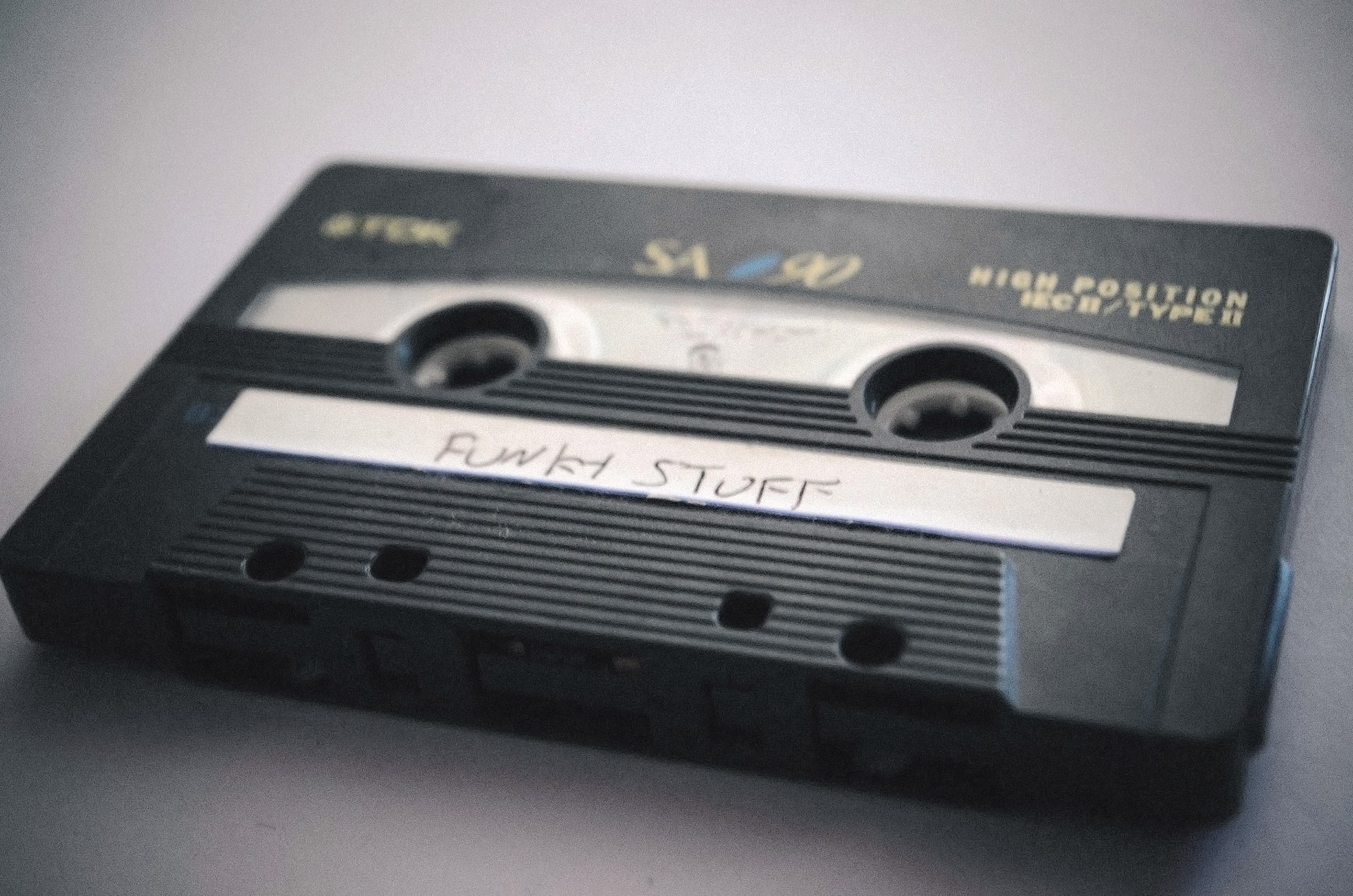
Someone gave me this tape by a DJ called Jerry Thomas. It's upbeat, high tempo stuff, of the type we used to hear a lot at Turnmills.
この音楽は1980年代にニューヨークやロサンゼルス地域から流れたヒップホップ・カルチャーへの反動であり、イースト・コースト・ヒップホップやウェス ト・コースト・ヒップホップと並ぶ、アメリカ第3の主要なヒップホップ・シーンと見なすことができる[4]。 初期の南部ラップ・アーティストの多くは、1990年代にレコード・レーベルとの契約を確保するのに苦労した後、インディペンデントまたはミックステープ で音楽をリリースした[5]。

「ある人からジェリー・トーマスというDJのテープをもらった。ターンミルズでよく聞いていたような、アップビートでハイテンポなものだ」。
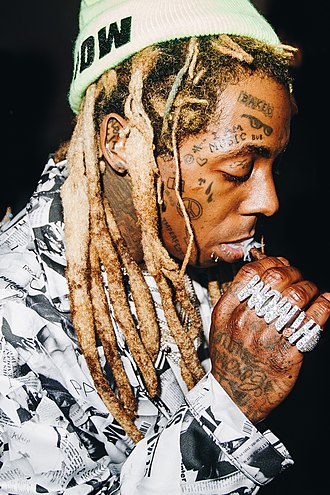
New Orleans rapper Lil Wayne
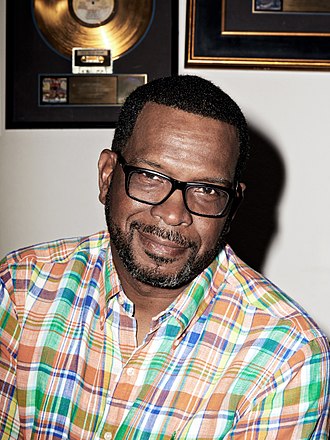
Uncle Luke
Miami rapper Uncle Luke, considered one of the pioneers of Southern Hip Hop
Throughout the 1980s and 1990s, the American hip hop music market was primarily dominated by artists from the East Coast and West Coast. Los Angeles and New York City were the two main cities where hip hop was receiving widespread attention. The West Coast was mainly represented by groups like N.W.A., Death Row Records, and the East Coast had people like The Notorious B.I.G. and groups like the Wu-Tang Clan, Mobb Deep and Bad Boy Records.[6] In the mid 1980s, cities throughout the Southern United States began to catch on to the hip hop music movement.[6] The Geto Boys, a hip hop group from Houston, were among the first hip hop artists from the Southern United States to gain widespread popularity. Southern hip hop's roots can be traced to the success of the group's Grip It! On That Other Level in 1989, the Rick Rubin-produced The Geto Boys in 1990, and We Can't Be Stopped in 1991.[7]
By the mid-1990s, Atlanta had become a center in Southern hip hop music. Local production crews such as Organized Noize that represented hip hop groups such as OutKast and Goodie Mob played a huge part in helping the South become a center for hip hop music.[8][9][10]
A defining moment for Southern rap was at the 1995 Source Awards. The duo Outkast had just been awarded Best New Artist, and within the tension that was the East Coast–West Coast feud, member André 3000 came up on stage followed by boos and said, "But it's like this though, I'm tired of them closed minded folks, it's like we gotta demo tape but don't nobody want to hear it. But it's like this: the South got something to say, that's all I got to say." As stated by rapper T.I., "Outkast, period. Outkast. That's when it changed. That was the first time when people began to take Southern rap seriously."[11]
In 1995, another iconic group, Nappy Roots, started releasing music. They eventually went triple platinum with hits such as Watermelon, Chicken & Gritz. Po Folks and worked with Kanye West, Jimmy Jam and Terry Lewis, and others.The most successful Southern independent labels during the mid-to-late 90s came out of the cities of Memphis and New Orleans. Both scenes borrowed heavily from a production style first introduced by way of the obscure late-1980s New York rap group The Showboys, heavily sampling the beats from their song "Drag Rap (Trigger Man)".[12] By the early 2000s, these scenes found mainstream success through Disturbing tha Peace in Atlanta, Cash Money Records and No Limit Records out of New Orleans, and Hypnotize Minds out of Memphis, revolutionizing financial structures and strategies for independent Southern rap labels. According to HipHopDX, "Not only is the South on the radar, but now the region that was an underdog is the barometer for rap music and hip-hop culture."[13] By the early to mid-2000s, artists from all over the South had begun to develop mainstream popularity with artists like Slim Thug, Paul Wall, Mike Jones, and Lil Keke from Houston; T.I., Ludacris, Bubba Sparxxx, Lil Jon, Gucci Mane and Young Jeezy from Atlanta; Trick Daddy and Rick Ross from Miami; Master P, B.G., Lil Wayne and Juvenile from New Orleans, and Three 6 Mafia and Yo Gotti from Memphis all becoming major label stars during this time.[14][15]
Southern hip hop peaked in popularity from 2002 through 2004. In 2002, Southern hip hop artists accounted for 50 to 60 percent of the singles on hip hop music charts. On the week of December 13, 2003, Southern urban artists, labels and producers accounted for six of the top 10 slots on the Billboard Hot 100: OutKast (with two singles), Ludacris, Kelis (produced by The Neptunes), Beyoncé and Chingy (on Ludacris' Disturbing Tha Peace label). Additionally, from October 2003 through December 2004, the number one position on the Billboard Hot 100 pop chart was held by a Southern urban artist for 58 out of 62 weeks. This was capped by the week of December 11, 2004 when seven out of the top ten songs on the chart were held by or featured Southern urban artists. In 2004, Vibe magazine reported that Southern artists accounted for 43.6% of the airplay on urban radio stations (compared to 29.7% for the Midwest, 24.1% for the East Coast and 2.5% for the West coast).[16]

ニューオリンズのラッパー、リル・ウェイン

アンクル・ルーク
サザン・ヒップホップのパイオニアの一人とされるマイアミのラッパー、アンクル・ルーク
1980年代から1990年代にかけて、アメリカのヒップホップ音楽市場は主に東海岸と西海岸のアーティストによって支配されていた。ロサンゼルスと ニューヨークは、ヒップホップが広く注目されていた2大都市だった。西海岸は主にN.W.A.やデス・ロウ・レコードのようなグループに代表され、東海岸 にはザ・ノトーリアス・B.I.G.やウータン・クラン、モッブ・ディープ、バッド・ボーイ・レコードのようなグループがいた[6]。 1980年代半ばになると、アメリカ南部の都市がヒップホップ音楽のムーブメントに乗り始めた[6]。 ヒューストン出身のヒップホップ・グループ、ゲト・ボーイズは、アメリカ南部出身のヒップホップ・アーティストとして初めて広く人気を得た。南部ヒップ ホップのルーツは、同グループの『Grip It』の成功まで遡ることができる!On That Other Level』(1989年)、リック・ルービンのプロデュースによる『The Geto Boys』(1990年)、『We Can't Be Stopped』(1991年)の成功が挙げられる[7]。
1990年代半ばまでに、アトランタは南部ヒップホップ・ミュージックの中心地となった。アウトキャストやグッディ・モブなどのヒップホップ・グループを 代表するオーガナイズド・ノイズなどの地元プロダクション・クルーは、南部がヒップホップ・ミュージックの中心地になるのに大きな役割を果たした[8] [9][10]。
南部ラップの決定的な瞬間は、1995年のソース・アワードであった。デュオのアウトカストは最優秀新人賞を受賞したばかりで、東海岸と西海岸の確執とい う緊張感の中、メンバーのアンドレ3000がステージに上がり、ブーイングを浴びながらこう言った。南部に言いたいことがある、それだけだ」。ラッパーの T.I.はこう言っている。アウトキャスト。それが変わった時だ。人々が南部のラップを真剣に受け止め始めた最初の時だった」[11]。
1995年、もうひとつの象徴的なグループ、ナッピー・ルーツが音楽をリリースし始めた。彼らは最終的に『Watermelon』『Chicken & Gritz』などのヒット曲でトリプル・プラチナを獲得した。90年代半ばから後半にかけて最も成功した南部のインディペンデント・レーベルは、メンフィ スとニューオーリンズの都市から生まれた。どちらのシーンも、1980年代後半に無名のニューヨーク・ラップ・グループ、ザ・ショウボーイズによって初め て紹介されたプロダクション・スタイルから、彼らの曲「Drag Rap (Trigger Man)」からビートを大量にサンプリングしている。[12] 2000年代初頭までに、これらのシーンは、アトランタのディスタービング・タ・ピース、ニューオーリンズのキャッシュ・マネー・レコードとノー・リミッ ト・レコード、メンフィスのヒプノタイズ・マインズによってメインストリームでの成功を収め、南部のインディペンデント・ラップ・レーベルの財政構造と戦 略に革命をもたらした。HipHopDXによると、「南部がレーダーに映るだけでなく、今や負け犬だった地域がラップ・ミュージックとヒップホップ・カル チャーのバロメーターになっている」[13][13] 2000年代初頭から半ばまでに、南部各地のアーティストがメインストリームで人気を博し始め、ヒューストン出身のSlim Thug、Paul Wall、Mike Jones、Lil Keke、T.I、 アトランタのT.I.、リュダクリス、ババ・スパーxxx、リル・ジョン、グッチ・マネ、ヤング・ジージー、マイアミのトリック・ダディ、リック・ロス、 ニューオーリンズのマスターP、B.G.、リル・ウェイン、ジュヴナイル、メンフィスのスリー6マフィア、ヨー・ゴッティといったアーティストがこの時期 にメジャーレーベルのスターとなった[14][15]。
南部ヒップホップの人気は2002年から2004年にかけてピークに達した。2002年、南部のヒップホップ・アーティストはヒップホップ音楽チャートの シングルの50から60パーセントを占めた。2003年12月13日付のビルボードホット100では、南部のアーバンアーティスト、レーベル、プロデュー サーがトップ10のうち6つを占め、アウトキャスト(シングル2曲)、リュダクリス、ケリス(ザ・ネプチューンズがプロデュース)、ビヨンセ、チンギー (リュダクリスのレーベルDisturbing Tha Peace所属)がランクインした。さらに、2003年10月から2004年12月まで、ビルボード・ホット100ポップ・チャートで1位を獲得したの は、62週中58週が南部のアーバン・アーティストだった。2004年12月11日の週には、チャートのトップ10のうち7曲が南部のアーバン・アーティ ストによるもの、もしくは南部のアーバン・アーティストをフィーチャーしたものだった。2004年、『ヴァイブ』誌は、南部のアーティストがアーバンラジ オ局のエアプレイの43.6%(中西部は29.7%、東海岸は24.1%、西海岸は2.5%)を占めたと報告している[16]。
See also: Bounce music
In the late 1990s "bounce" music was born in New Orleans. Master P established No Limit Records. In 1992, Cash Money Records was founded, releasing bounce and gangsta rap music.
Florida
Main article: Miami bass
The single "Throw The D" by the group 2 Live Crew in January 1986 was the first Miami bass song. Fresh Kid Ice (Christopher Wong Won) said that the song came about when he noticed a new popular dance in Miami, when Herman Kelly and Life's song "Dance to the drummer's beat" played.[17] 2 Live Crew released their album As Nasty As They Wanna Be in 1989.[18]
Tennessee
See also: Memphis rap
Three 6 Mafia, DJ Paul, Juicy J, Lord Infamous, Koopsta Knicca, Crunchy Black, Gangsta Boo, La Chat, Project Pat, Indo G, Playa Fly, Eightball and MJG, Yo Gotti, Moneybagg Yo, NLE Choppa, Pooh Shiesty, and Young Dolph all came from Memphis, Tennessee.[19][20]
Alabama
The gangsta rap group Dirty is from Montgomery, Alabama.[21]
Georgia
See also: Atlanta hip hop, Music of Atlanta, and Trap music (hip hop)
In 2009, the New York Times called Atlanta "hip-hop's center of gravity",[22] and the city is home to many famous hip-hop, R&B and neo soul musicians.[23]
In the 1980s and early 1990s, Atlanta's hip hop scene was characterized by a local variant of Miami bass, with stars like Kilo Ali and DJ Smurf (later Mr. Collipark).[22][24]
By the mid-1990s, the rise of OutKast, Goodie Mob[25] and the production collective Organized Noize, let to the development of the Dirty South style of hip-hop and of Atlanta gaining a reputation for "soul-minded hip-hop eccentrics", contrasting with other regional styles. On August 3, 1995, Outkast received the award for Best New Artist in New York City at the Source Awards. At the time, the primary hip hop heard nationally was from artists on the East and West Coasts, due at least partly to high- profile disputes between rappers from each coast. It was groups such as Outkast who were determined to let the world know that the South had something to say.[22]
In 2009, it was noted that after 2000/2001, Atlanta moved "from the margins to becoming hip-hop's center of gravity, part of a larger shift in hip-hop innovation to the South", primarily due to the massive popularity of Waka Flocka Flame's 2009 debut mixtape. Producer Drumma Boy called Atlanta "the melting pot of the South". Producer Fatboi called the Roland TR-808 ("808") synthesizer "central" to Atlanta music's versatility, used for snap, crunk, trap, and pop rap styles.[22] The same article named Drumma Boy, Fatboi, Shawty Redd, Lex Luger and Zaytoven the five "hottest producers driving the city".[22]
Texas
See also: Chopped and screwed
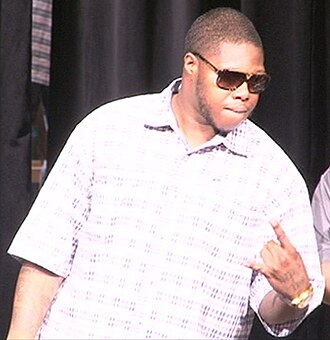
Houston's Hip Hop artist Z-ro.
Hip hop artist Z-Ro from Houston, Texas
In the late 1980s, the Geto Boys were Houston's first hip hop group to gain mainstream popularity. In the early 1990s, Texas groups such as Nemesis, PKO, and UGK (from Dallas, San Antonio, and Port Arthur respectively) also gained popularity. Before the early 1990s, most Southern hip hop was upbeat and fast, like Miami bass and crunk. In Texas, however, the music started to become slower. In the early 1990s, DJ Screw created "chopped and screwed" music. Although people associated with Screw have indicated any time between 1987 and 1991, Screw said he started slowing music down in 1990. In Tulsa, Oklahoma, DJ Dinero and DJ Z-Nasty helped popularize chopped and screwed music in the Mid South.[26][27]
Between 1991 and 1992, there was increased abuse of purple drank in East Texas. Purple drank was a major influence in chopped and screwed music due to its effect of slowing down perception. DJ Screw, a known user of purple drank, said that it is not required to enjoy chopped and screwed music and that he came up with the style when high on marijuana.[26]
As the spread of Southern hip hop continued, its mainstream breakthrough occurred in 2000. Duo UGK made a high-profile guest appearance on Jay-Z's hit "Big Pimpin'" and also appeared on Three 6 Mafia's hit "Sippin' on Some Syrup". Both of these collaborations greatly increased their reputation and helped fuel anticipation for their next project. UGK's Pimp C died from a sudden heart attack after overdosing on purple drank on December 4, 2007 at the age of 33. A song that originally appeared on the compilation album The Day Hell Broke Loose 2, Mike Jones' "Still Tippin'", achieved mainstream success in 2004 leading to local Houston rap label Swishahouse signing a national distribution deal with Asylum Records. Jones released his major label debut, Who Is Mike Jones?, on Swishahouse/Warner Bros. in April 2005 and was certified platinum that June.[28] Paul Wall's major label debut, The Peoples Champ, on Swishahouse/Atlantic, was released in September 2005, eventually topping the Billboard 200.[29]
North Carolina
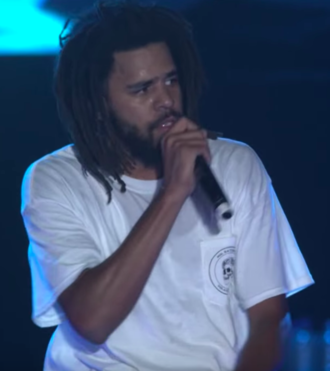
jermaine cole
North Carolina rapper J. Cole
Around the same time, Ski Beatz (of Greensboro) produced "Dead Presidents" on Jay-Z's album "Reasonable Doubt", which was released in 1996. Also, 9th Wonder (of Winston-Salem) joined a group named Little Brother with fellow members Big Pooh and Phonte (of Durham).(9th Wonder left Little Brother in 2007 to solo produce, becoming one of the top 10 most successful hip hop producers of all time).
North Carolina did not hit the mainstream hip hop map until 2001 with Petey Pablo's "Raise Up". This song was wildly successful and helped shine a much-needed national spotlight on North Carolina's burgeoning rap industry, along with some of its biggest names and some longtime rappers from the state: Rapsody, King Mez, Kooley High, Ignite Mindz, Drique London, SkyBlew, Azon Blaze, Donovan McCray, Lazarus, Thee Tom Hardy, Troop 41, Bryce Snow, Lute, Deniro Farrar, Justus League, Edgar Allen Floe, L.E.G.A.C.Y., Kaze, Ease, Banknote Mitch, Khrysis, Keaton, Wells, Tucson, Ghost Dog, & many more.[30]
North Carolina really reached full acceptance into hip hop's heights with the rise of J Cole and his Dreamville Records (Fayetteville) in the early 2010s, which still see successful Dreamville Music Festivals being organized and thrown annually in 2021.
Another noteworthy rap artist from North Carolina is DaBaby, hailing from Charlotte, though he was born in Cleveland. Although sometimes drawing attention from self-created controversies, his lyrical skills, mixed with his exposure and unique voice, have made him a reckonable force in hip-hop.
Crunk
Main article: Crunk
The term crunk is mainly used to denote a musical style that was originated by Three Six Mafia in Memphis, Tennessee, in the mid-to-late 1990s. It was popularized by Atlanta rapper Lil Jon,[31] and gained mainstream popularity in the period 2003–04.[32] A typical crunk track uses a drum machine rhythm, heavy bassline, and shouting vocals, often in call and response manner.[32]
こちらも参照: バウンス・ミュージック
1990年代後半、ニューオーリンズで「バウンス」ミュージックが誕生した。マスターPがノー・リミット・レコードを設立。1992年にはキャッシュ・マ ネー・レコードが設立され、バウンスとギャングスタ・ラップをリリース。
フロリダ
主な記事 マイアミ・ベース
1986年1月、グループ2ライブ・クルーのシングル「Throw The D」が最初のマイアミ・ベース・ソングとなった。フレッシュ・キッド・アイス(クリストファー・ウォンウォン)は、ハーマン・ケリー・アンド・ライフの曲 「ドラマーのビートに合わせて踊ろう」が流れた時、マイアミで新しい人気のダンスに気づいたことがこの曲のきっかけだと語っている[17]。2ライブ・ク ルーは1989年にアルバム『As Nasty As They Wanna Be』をリリースした[18]。
テネシー州
こちらも参照: メンフィス・ラップ
スリー6マフィア、DJポール、ジューシーJ、ロード・インファマス、クープスタ・クニッカ、クランチー・ブラック、ギャングスタ・ブー、ラ・チャット、 プロジェクト・パット、インドG、プラヤ・フライ、エイトボールとMJG、ヨー・ゴッティ、マネーバグ・ヨー、NLEチョッパ、プー・シースティ、ヤン グ・ドルフはテネシー州メンフィス出身[19][20]。
アラバマ
ギャングスタ・ラップ・グループのダーティはアラバマ州モンゴメリー出身[21]。
ジョージア州
こちらも参照: アトランタ・ヒップホップ、アトランタの音楽、トラップ・ミュージック(ヒップホップ)
2009年、ニューヨーク・タイムズ紙はアトランタを「ヒップホップの重心」と呼び[22]、アトランタには有名なヒップホップ、R&B、ネオソ ウルのミュージシャンが多く住んでいる[23]。
1980年代から1990年代初頭にかけて、アトランタのヒップホップ・シーンは、キロ・アリやDJスマーフ(後のミスター・コリパーク)といったスター を擁する、マイアミ・ベースの地元版という特徴を持っていた[22][24]。
1990年代半ばになると、アウトキャスト、グッディ・モブ[25]、プロダクション集団のオーガナイズド・ノイズが台頭し、ダーティー・サウス・スタイ ルのヒップホップが発展し、アトランタは他の地域のスタイルとは対照的な「ソウル・マインドを持ったヒップホップの変わり者」という評判を得るようになっ た。1995年8月3日、アウトカストはニューヨークのソース・アワードで最優秀新人賞を受賞。当時、全国的にヒップホップを耳にするのは東海岸と西海岸 のアーティストが中心だった。アウトキャストのようなグループは、南部に言いたいことがあることを世界に知らしめようと決意していた[22]。
2009年、ワカ・フロッカ・フレイムの2009年のデビューミックステープの大人気により、2000年/2001年以降、アトランタは「ヒップホップの 端から端に移動し、ヒップホップ革新の南部への大きなシフトの一部として、ヒップホップの重心になった」と指摘された。プロデューサーのドラマ・ボーイは アトランタを「南部のるつぼ」と呼んだ。プロデューサーのファットボイは、ローランドTR-808(「808」)シンセサイザーをアトランタの音楽の多様 性の「中心」と呼び、スナップ、クランク、トラップ、ポップラップのスタイルに使用されている[22]。 同じ記事では、ドラマ・ボーイ、ファットボイ、ショーティ・レッド、レックス・ルーガー、ゼイトヴェンの5人を「この街を牽引する最もホットなプロデュー サー」としている[22]。
テキサス
こちらも参照: チョップド・アンド・スクリュード

ヒューストンのヒップホップアーティストZ-RO
テキサス州ヒューストン出身のヒップホップアーティストZ-Ro
1980年代後半、ゲト・ボーイズはヒューストンで初めてメインストリームで人気を得たヒップホップ・グループだった。1990年代初頭には、 Nemesis、PKO、UGK(それぞれダラス、サンアントニオ、ポートアーサー出身)といったテキサスのグループも人気を博した。1990年代初頭以 前、南部のヒップホップのほとんどは、マイアミ・ベースやクランクのようなアップビートで速いものだった。しかし、テキサスでは音楽がスローになり始め た。1990年代初頭、DJスクリューが「チョップド・アンド・スクリュード」ミュージックを生み出した。スクリューの関係者は1987年から1991年 にかけての時期を指摘しているが、スクリューは1990年に音楽をスローダウンさせ始めたと語っている。オクラホマ州タルサでは、DJディネロとDJ Z-ナスティが中南部でのチョップド・アンド・スクリュードの普及に貢献した[26][27]。
1991年から1992年にかけて、東テキサスではパープルドランクの乱用が増加した。パープルドランクは知覚を鈍らせる効果があるため、チョップド・ア ンド・スクリュード・ミュージックに大きな影響を与えた。パープル・ドランクの使用者として知られるDJスクリューは、チョップド・アンド・スクリュード の音楽を楽しむのにパープル・ドランクは必要なく、マリファナでハイになっているときにこのスタイルを思いついたと語っている[26]。
サザン・ヒップホップの普及が続く中、メインストリームでのブレイクは2000年に起こった。デュオUGKはジェイ・Zのヒット曲「Big Pimpin'」にゲスト出演し、スリー・シックス・マフィアのヒット曲「Sippin' on Some Syrup」にも参加した。この2つのコラボレーションは彼らの評判を大いに高め、次のプロジェクトへの期待感を煽るのに役立った。UGKのピンプCは 2007年12月4日、パープル・ドリンクの過剰摂取による突然の心臓発作で33歳の若さで亡くなった。コンピレーション・アルバム『The Day Hell Broke Loose 2』に収録されていたマイク・ジョーンズの「Still Tippin'」は、2004年にメインストリームで成功を収め、ヒューストンの地元ラップ・レーベル、スウィシャハウスはアサイラム・レコードと全国流 通契約を結んだ。ジョーンズは2005年4月にSwishahouse/Warner Bros.からメジャーデビュー作『Who Is Mike Jones?"』をリリースし、同年6月にプラチナ認定を受けた[28]。ポール・ウォールは2005年9月にSwishahouse/Atlantic からメジャーデビュー作『The Peoples Champ』をリリースし、最終的にBillboard 200のトップを飾った[29]。
ノースカロライナ

ジャーメイン・コール
ノースカロライナのラッパー、J.コール
同じ頃、Ski Beatz(グリーンズボロ出身)は、1996年にリリースされたJay-Zのアルバム『Reasonable Doubt』に収録されている「Dead Presidents」をプロデュース。また、9th Wonder(ウィンストン・セーラム出身)は、仲間のBig Pooh、Phonte(ダーラム出身)と共にLittle Brotherというグループに参加した(9th Wonderは2007年にLittle Brotherを脱退し、ソロ・プロデュースとして、ヒップホップ・プロデューサーとして最も成功したトップ10に入る)。
ノースカロライナがメインストリームのヒップホップ・マップに登場したのは、2001年のPetey Pabloの "Raise Up "からだ。この曲は大成功を収め、急成長を遂げるノースカロライナのラップ業界に全国的なスポットライトを当てるきっかけとなった: Rapsody、King Mez、Kooley High、Ignite Mindz、Drique London、SkyBlew、Azon Blaze、Donovan McCray、Lazarus、Thee Tom Hardy、Troop 41、Bryce Snow、Lute、Deniro Farrar、Justus League、Edgar Allen Floe、L.E.G.A.C.Y.、Kaze、Ease、Banknote Mitch、Khrysis、Keaton、Wells、Tucson、Ghost Dog、その他多数[30]。
ノースカロライナは、2010年代初頭にJ・コールと彼のドリームヴィル・レコーズ(フェイエットヴィル)が台頭し、ヒップホップの高みに完全に受け入れ られるようになった。
ノースカロライナ出身のもう一人の注目すべきラップ・アーティストは、クリーブランド生まれだがシャーロット出身のDaBabyだ。時には自作自演の論争 で注目を集めることもあるが、そのリリック・スキルと露出度の高さ、ユニークな歌声が相まって、ヒップホップ界では侮れない存在となっている。
クランク
主な記事 クランク
クランクという言葉は主に、1990年代半ばから後半にかけてテネシー州メンフィスでスリー・シックス・マフィアによって創始された音楽スタイルを示すの に使われる。アトランタのラッパーであるリル・ジョンによって広まり[31]、2003年から04年にかけてメインストリームで人気を博した[32]。典 型的なクランク・トラックは、ドラム・マシーンのリズム、ヘヴィなベースライン、シャウトするヴォーカルを使用し、しばしばコール・アンド・レスポンス方 式である[32]。
Mumble rap
Trap music
Snap music
Characteristics
Latin trap is a subgenre of Latin hip hop, taking influence from Southern hip hop as well as Puerto Rican genres like reggaeton and dembow. Vocals include a bend of rapping and singing using synthesizers and voice distorted autotune, often in Spanish, while still maintaining the trap style sonic circuitry.[3] The lyrics in Latin trap are often about street life, violence, sex, drugs, and people who live on the other side of the law and are proud of it.[1]
特徴
ラテン・トラップはラテン・ヒップホップのサブジャンルであり、サザン・ヒップ・ホップ(上掲)やレゲトンやデンボウの ようなプエルトリコのジャンルから影響を受けている。ヴォーカルは、トラップ・スタイルのサウンド回路を維持しながらも、シンセサイザーや音声歪みオート チューンを使用したラップと歌の曲げを含み、しばしばスペイン語で歌われる[3]。ラテン・トラップの歌詞は、ストリート・ライフ、暴力、セックス、ド ラッグ、法の反対側に生き、それを誇りに思う人々についてであることが多い[1]。d
2000s
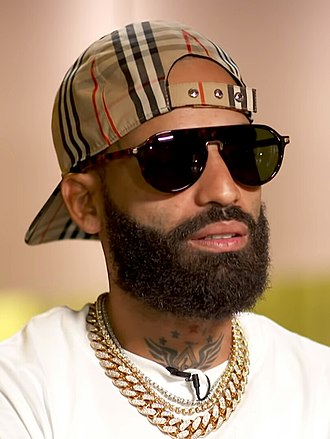
Arcángel, considered one of pioneers of Latin trap.
Latin trap originated in Puerto Rico and gained popularity throughout Latin America. The exact date of origin is unknown and has been widely debated. Puerto Rican reggaeton and Latin trap singer Ozuna states that it originated in 2007 with the song "El Pistolón", performed by Arcángel & De La Ghetto, Yaga & Mackie, and Jowell & Randy (the former two were duo at the time). De La Ghetto on the other hand, states that he has been performing Latin trap since around 2005 or 2006, and that people thought "he was crazy". Reggaeton artists at this time wanted to introduce elements of American hip hop and R&B to a Spanish audience.[4]
2010s
Latin trap began to gain prominence around 2014 when artists such as Alvaro Diaz, Myke Towers and Fuete Billete, the first Puerto Rican artists using early Latin trap beats to rap, began posting their songs through social media platforms. In mid-2015, Cuban artist TRAUMATIZE from Miami, FL releases "Aguadulce" latin trap record, a collaborator of the American Hip Hop group Bone Thugs-n-Harmony. This new sound eventually gained popularity in Puerto Rico, and many Latin trap hits emerged, such as Anuel AA’s "47 Remix" Bryant Myers' "Esclava Remix", Farruko's "Ella y Yo", and De La Ghetto's "La Ocasión", the latter to which Ozuna and Anuel AA credits with expanding Latin trap internationally.[5]
A Spanish version of "Panda" was released by Almighty on the Miami-based label Carbon Fiber Music.[6] The single reached #36 on Hot Latin Songs and #23 on Latin Rhythm Airplay. Borrowing the original version's beat, it features Farruko, owner of said label, while a subsequent remix adds Daddy Yankee and Cosculluela.[7] Additionally, Anuel AA released a scathing diss track towards Almighty, entitled "RIP Panda", after being taken down from the remix.[8]
In July 2017, The Fader wrote: "Rappers and reggaetoneros from Puerto Rico have taken elements of trap – the lurching bass lines, jittering 808s and the eyes-half-closed vibe – and infused them into banger after banger."[9] In an August 2017 article for Billboard's series, "A Brief History Of", they enlisted some of the key artists of Latin trap, including Ozuna, De La Ghetto, Bad Bunny, Farruko and Messiah- to narrate a brief history on the genre.[10][11] Elias Leight of Rolling Stone noted: "[Jorge] Fonseca featured Puerto Rican artists like Anuel AA, Bryant Myers and Noriel on the compilation Trap Capos: Season 1, which became the first "Latin trap" LP to reach number one on Billboard's Latin Rhythm Albums chart."[12]
Many other reggaeton and Latin trap artists contributed to the popularity of Latin trap, such as Bad Bunny who led an explosion to the popularity of the genre.[13] Bad Bunny produced several songs that made it into Billboard's Hot Latin Songs chart and has multiple collaborations with popular American artists such as Nicki Minaj, Travis Scott, and Cardi B.[14][15] He shortly became the face of Latin trap's sudden rise in popularity.[16] Through collaborations with other artists, such as his appearance in Becky G's "Mayores", Bad Bunny was among the first Latin trap artists to ever rap on the radio. His appearance on the radio has led to an increased recognition of Latin trap in the United States.[16] His debut album X 100pre was released in December 2018 and was awarded with a Latin Grammy for Best Urban Music Album.[17]
In April 2018, the song "Te Boté", a mix of Latin trap and reggaeton, was released by Nio García, Casper Mágico, Darell, Ozuna, Bad Bunny and Nicky Jam.[18] It became the first song with Latin trap elements in it to reach number one on the Billboard Hot Latin Songs chart. It currently has over 2 billion views on YouTube.[19]
In 2018, Cardi B's hit single "I Like It" featuring Bad Bunny and J Balvin became the first Latin trap song to reach number one on the US Billboard Hot 100 chart.[20][21]
Current
J Balvin and Bad Bunny appear at the 2020 Super Bowl Halftime Show performing latin trap songs for the first time in history.[22]
Bad Bunny is the most influential Latin trap artist being named one of Time’s 100 Most Influential People of 2021.[23] Bad Bunny is currently at his peak being named Spotify's most streamed artist of 2021 and 2022. On May 6, 2022 Bad Bunny released his album Un Verano Sin Ti reaching the milestone of most-streamed artist globally in one day, with 183 million streams.[24] In 2023, Bad Bunny release his album, Nadie Sabe Lo Que Va A Pasar Manana, which was considered one of his first true Latin trap albums since 2020.
2000s

ラテン・トラップのパイオニアの一人とされるArcángel。
ラテン・トラップはプエルトリコで生まれ、ラテン・ アメリカ全土で人気を博した。正確な起源は不明であり、広く議論されている。プ エルトリコ出身のレゲトン/ラテン・トラップ・シンガーであるオズーナは、2007年にアルカンヘル&デ・ラ・ゲットー、ヤガ&マッキー、ジョウェル&ラ ンディ(前者2人は当時デュオだった)が演奏した「El Pistolón」が起源だと述べている。一方、デ・ラ・ゲットは2005年か2006年頃からラテン・トラップを披露しており、「彼はクレイジーだ」と 思われていたと述べている。この時期のレゲトン・アーティストたちは、アメリカのヒップホップやR&Bの要素をスペインのオーディエンスに紹介し たいと考えていた[4]。
2010s
ラテン・トラップは、初期のラテン・トラップのビートをラップに使用した最初のプエルトリコ人アーティストであるアルバロ・ディアス、マイケ・タワーズ、 フエテ・ビレテといったアーティストが、ソーシャルメディア・プラットフォームを通じて楽曲を投稿し始めた2014年頃から注目を集め始めた。2015年 半ばには、フロリダ州マイアミ出身のキューバ人アーティストTRAUMATIZEが、アメリカのヒップホップ・グループBone Thugs-n-Harmonyとコラボレートしたラテン・トラップ・レコード "Aguadulce "をリリース。この新しいサウンドはやがてプエルトリコで人気を博し、アヌエルAAの「47 Remix」、ブライアント・マイヤーズの「Esclava Remix」、ファルッコの「Ella y Yo」、デ・ラ・ゲットの「La Ocasión」など、多くのラテン・トラップのヒット曲が生まれた。
Panda "のスペイン語バージョンは、マイアミのレーベルCarbon Fiber MusicからAlmightyによってリリースされ、Hot Latin Songsで36位、Latin Rhythm Airplayで23位を獲得した[6]。オリジナル・バージョンのビートを借り、同レーベルのオーナーであるFarrukoをフィーチャーし、その後の リミックスではDaddy YankeeとCosculluelaが加わっている[7]。さらに、Anuel AAはリミックスから降ろされた後、"RIP Panda "と題したAlmightyに対する辛辣なディス・トラックをリリースした[8]。
2017年7月、The Faderは「プエルトリコ出身のラッパーとレゲトネーロは、トラップの要素、つまり揺れ動くベースライン、ジタバタする808、目を半分閉じたような ヴァイブを取り入れ、次々とバンガーに吹き込んでいる。 "9]2017年8月のBillboardのシリーズ "A Brief History Of "の記事では、Ozuna、De La Ghetto、Bad Bunny、Farruko、Messiahなど、ラテン・トラップの主要なアーティストを起用し、このジャンルに関する簡単な歴史を語っている[10] [11]。 Rolling StoneのElias Leightはこう指摘している: ホルヘ・フォンセカは、アヌエル・AA、ブライアント・マイヤーズ、ノリエルといったプエルトリコ出身のアーティストをコンピレーション『Trap Capos』でフィーチャーした: シーズン1は、ビルボードのラテン・リズム・アルバム・チャートで1位を獲得した初の "ラテン・トラップ "LPとなった」[12]。
バッド・バニーはビルボードのホット・ラテン・ソング・チャートにランクインした楽曲をプロデュースし、ニッキー・ミナージュ、トラヴィス・スコット、 カーディ・Bといったアメリカの人気アーティストと複数のコラボレーションを行っている。 [14][15]彼は間もなく、ラテン・トラップの人気急上昇の顔となった。[16]ベッキーGの「Mayores」への出演など、他のアーティストとの コラボレーションを通して、バッド・バニーはラジオでラップを披露した最初のラテン・トラップ・アーティストの一人となった。彼のラジオへの出演は、アメ リカにおけるラテン・トラップの認知度向上につながった[16]。 2018年12月にリリースされたデビュー・アルバム『X 100pre』は、ラテン・グラミー賞の最優秀アーバン・ミュージック・アルバム賞を受賞した[17]。
2018年4月、ニオ・ガルシア、キャスパー・マジコ、ダレル、オズナ、バッド・バニー、ニッキー・ジャムによるラテン・トラップとレゲトンをミックスし た楽曲「Te Boté」がリリースされ、ラテン・トラップの要素を取り入れた楽曲として初めてビルボード・ホット・ラテン・ソングス・チャートで1位を獲得した [18]。現在YouTubeでの再生回数は20億回を超えている[19]。
2018年、バッド・バニーとJ・バルヴィンをフィーチャーしたカーディ・Bのヒット・シングル「アイ・ライク・イット」は、ラテン・トラップ曲として初 めて全米ビルボード・ホット100チャートで1位を獲得した[20][21]。
現在
J・バルヴィンとバッド・バニーは2020年のスーパーボウルのハーフタイムショーに登場し、史上初めてラテントラップの曲を披露した[22]。
バッド・バニーは最も影響力のあるラテン・トラップ・アーティストであり、タイム誌の「2021年最も影響力のある100人」に選ばれている[23]。 バッド・バニーは現在、2021年と2022年のSpotifyで最もストリーミングされたアーティストに選ばれ、絶頂期にある。2022年5月6日、 バッド・バニーはアルバム『Un Verano Sin Ti』をリリースし、1億8,300万ストリーミングを記録し、1日で最もストリーミングされたアーティストとなった[24]。 2023年、バッド・バニーはアルバム『Nadie Sabe Lo Que Va A Pasar Manana』をリリースし、2020年以来初の真のラテン・トラップ・アルバムとなった。
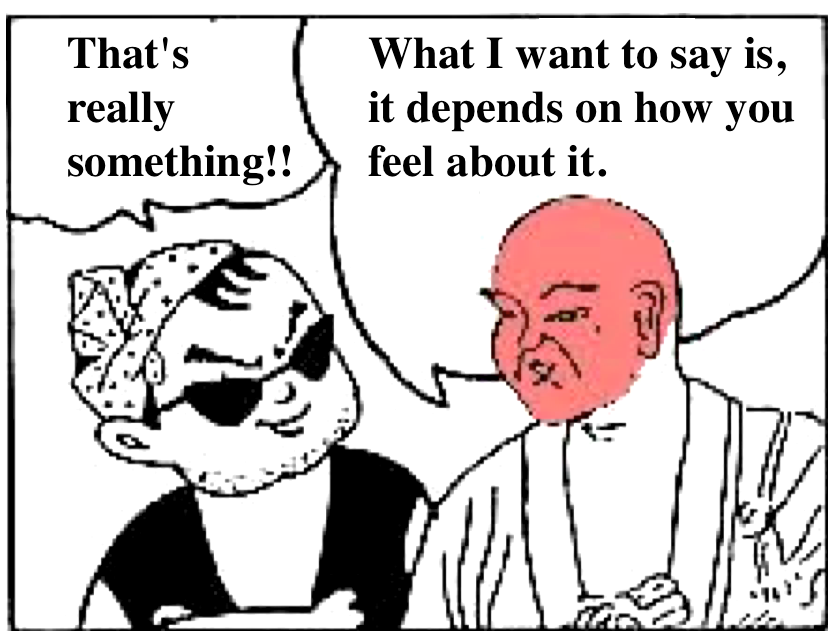
 ☆
☆